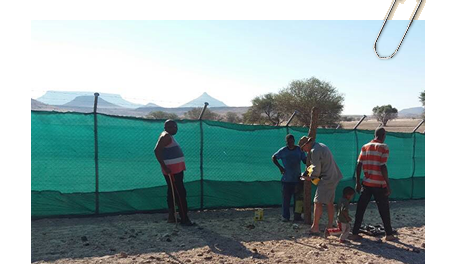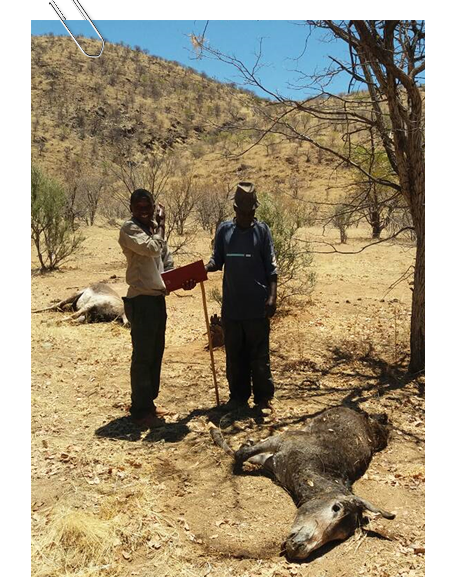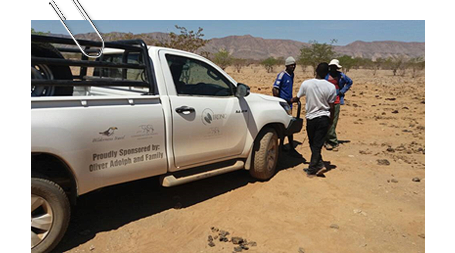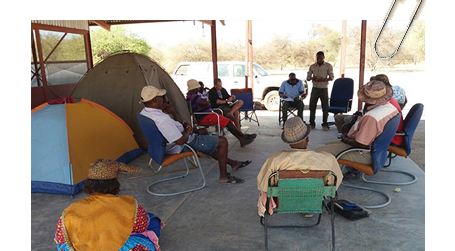Human Wildlife Conflict Mitigation
Two new lion-proof kraals have been constructed, one at Driefontein and one at Bergsig Pos, to reduce human wildlife conflicts. Several lion proof-kraals are expected to be erected. In addition to the fencing, motion activated solar powered spot lights have been purchased to fit the lion proof kraals. These will help to disturb approaching predators.
At present IRDNC has sourced funding for two dedicated vehicles, some running costs for these vehicles, limited camping and other equipment and salaries for the Team Leader/Co-ordinator and facilitator. The Team Leader is a Namibian from the Kunene Region and is a graduate of the Namibian University of Science and Technology.
It is worth noting from much experience, that rapid response to incidents and actually visiting the affected persons significantly defuses the situation. Rapid on site visits also are essential in gaining accurate data about the incident. The pilot early-warning project will also assist the teams in being pro-active, allowing them to arrive on site before livestock is lost. When not actually responding to human wildlife conflict incidents, the units members will be conducting extensive work amongst farmers/community members, liaising with TA’s and conservancy management, collecting data on settlements and livestock (it is hoped to use the same teams to respond to elephant problems in the North West). Through these teams, we hope to mentor conservancies and farmers into taking rational and objective decisions about lions and elephants and the challenges of living with these. This goes right from managing threats and incidents to drawing up and adopting conservancy management plans for these species.
The increased footprint of these teams on the ground will also help to deter poachers.
- Participating in lion conflict experience exchange meetings - September (Ongoing)
- Assessing human livestock settlement patterns - October (Ongoing)
- Introducing North-West Lion Management Plan to Conservancy committees and farmers (focal lion conservancies) - October (Ongoing)
- Introducing Lion Ranger Program - October/November (some conservancies have identified their rangers, others are still busy assessing their needs)
- Identifying human-lion conflict hotspots – with conservancy committees (identifying focal sites for lion-proof kraals) - November
- Responding to lion incidences (6 reactive responses - October/November) - (Okondjou, Otjandaue - Omatendeka; Ombaue-jejo, Ehi-rovipuka conservancy; Milk-post - Torra conservancy; Okaturua, Otjiperongo - Anabeb conservancy)
- Responding to possible lion incidents (proactive responses -1 response) - Okamaruru, Purros Conservancy)
Human - Wildlife Response Successful Interactions:
- Community engagement; on-site visit to farmers have been the most important response, as it shows positive receptions from farmers in most conservancies we have been visiting (in exception of Torra conservancy- not visited)
- Field response to lion incidences have been of great importance, as farmers feel being respected and considered
- Learning from exchange trips have been an important tool for self-capacity building in the lion conflict management (adopting Rhino Ranger model, and other field conservation expects e.g. Lion Guardian program)
Challenges:
- Community engagement; some communities have really bad attitude towards lions (Torra Conservancy management, and a few individuals in Sesfontein conservancy)
- Farmers are seen to have disregard towards conservation as whole, lions are being used as a scapegoat in this regard. The perception is that many farmers realize little or no benefit from conservancies, this due to little or imbalanced benefit distribution in most conservancies
- Engaging farmer’s concerns and needs regarding lions; as field operators don`t have answers for what farmers wants to hear regarding lions, such as compensation and lion off-takes
- Slow implementation process (Lion Rangers, Kraals and Early-warning system) (farmers want to see results)
Way-forward/Recommendations for 2018:
- Conservation challenges needs to be addressed; benefits to conservancies from tourism, wildlife and better ways to ensure all members benefits,
- Conservancy Committee capacity development is important (knowledge sharing), suggest Bi-annual Planning and Reporting meeting for all the Lion-Range Conservancies (Purros, Sesfontein, Anabeb, Torra, Omatendeka and Ehi-rovipuka conservancy)
- Lion-Range area is big, another team of field operator (vehicle and personnel) is crucial and urgent.
- Response training is highly recommended (monitoring and use of fire-works)
- Continued engagement with farmers
- Rapid response to reported incident is a priority
- Human livestock settlement pattern survey is ongoing.

- New lion-proof kraal in Kunene

- Cliff Tjitundi collecting data at a site in Omatendeka where five donkeys were killed by lions in October this year

- Cliff Tjitundi is conducting a human and livestock settlement survey as part of baseline data collection to improve HWC management in Kunene

- Cliff Tjitundi introducing the North West Human-Lion Conflict Management Plan priorities to Omatendeka Conservancy Committee



